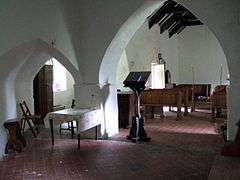Llanstinan
Llanstinan is a rural parish[1][2] in the community of Scleddau, north Pembrokeshire, Wales, 3 miles (4.8 km) south of Fishguard.
| Llanstinan | |
|---|---|
 Interior of St Justinian's | |
 Llanstinan Location within Pembrokeshire | |
| Community | |
| Principal area | |
| Country | Wales |
| Sovereign state | United Kingdom |
| Police | Dyfed-Powys |
| Fire | Mid and West Wales |
| Ambulance | Welsh |
| UK Parliament | |
| Senedd Cymru – Welsh Parliament |
|
History
Parish
Originally in the ancient Hundred of Dewisland, formerly a pre-Norman cantref, the parish is bordered in the west by the Western Cleddau river and in the east by Nant y Bugail; it is entirely rural.[1][2] Decayed but distinct prehistoric earthworks exist.[3] A 1578 map in the British Library shows the parish as Llannastynan.[4] A village named Llanstinan does not appear to have ever existed; the nearby villages of Trecwn in the east and Scleddau in the west have gained more prominence.[note 1] The population in 1801 was 114.[5] Lewis's Topographical Dictionary of 1833 gives the population as 168.[1] The 1849 edition expands the population to 170, and notes that there is a small slate quarry in the parish and a Calvinist Methodist place of worship.[6] By the 1870s the population was 174, in 36 houses.[7][8]
The parish is now part of the Benefice of Llanwnda (St Gwyndaf) and Goodwick (St Peter) with Manorowen and Llanstinan in the Diocese of St David's.[9]
Parish church
The parish church of St Justinian, isolated in farmland, is mediaeval or Norman in origin, but was substantially rebuilt in the 19th century. It is a Grade II* listed building.[10][11][12]
Notable people
Sir William Wogan (politician) was a member of the influential Wogan family of Llanstinan who died in 1710, leaving his estate to a Symmons relative. The Reverend Dr Charles Symmons (1749–1826) was a grandson of John Symmons (1701–64)[13] of Llanstinan. The Symmons family was a significant one in the area, and beyond.[14] Their seat was Llanstinan House,[15] which was acquired by a member of another significant local family, Sir Hugh Owen (1803–91), in the 19th century.[16] The Royal Commission in about 2003 published a paper on the status and history of the house, whose origins are thought to date back to the 16th century, and since then has seen luxurious times to more recent decay.[17][18] Richard Fenton in 1811 referred to Llanstinan as "...a place I shall ever remember, with an affection that I want words to express..."[19]
Notes
- The writer Elizabeth Rees in Celtic Sites and their Saints (see Further reading) asserts that Scleddau once surrounded the church but this part of the settlement has disappeared
References
- "GENUKI: Llanstinan". Retrieved 11 August 2019.
- "GENUKI: Parish map 30: Llanstinan". Retrieved 11 August 2019.
- An Inventory of the Ancient Monuments in Wales and Monmouthshire. IV. RCAHMW. 1914. p. 179.
- "Penbrok comitat". British Library. Retrieved 4 August 2019.
- Bell, James (1835). A new and comprehensive gazetteer of England and Wales. Oxford University.
Llanstinan Parish.
- "Samuel Lewis, 'Llansilin – Llanvabon', in A Topographical Dictionary of Wales (London, 1849), pp. 98–111. British History Online". Retrieved 11 August 2019.
- "GB Historical GIS / University of Portsmouth, History of Llanstinan in Pembrokeshire, A Vision of Britain through Time". Retrieved 11 August 2019.
- "Coflein Historic Place Names: Llanstinan". Retrieved 11 August 2019.
- "The Benefice of Llanwnda (St Gwyndaf) and Goodwick (St Peter) with Manorowen and Llanstinan". Retrieved 11 August 2019.
- "British Listed Buildings: Church of St Justinian". Retrieved 11 August 2019.
- Cadw. "Church of St Justinian (Grade II*) (20818)". National Historic Assets of Wales. Retrieved 11 August 2019.
- "Coflein: St Justinians Church". Retrieved 11 August 2019.
- "The History of Parliament: SYMMONS, John (1701-64), of Llanstinan, Pemb". Retrieved 11 August 2019.
- "Davies, W. Ll., (1959). SYMMONS family, of Llanstinan, Pembrokeshire". Dictionary of Welsh Biography. Retrieved 11 August 2019.
- "Coflein: Llanstinan House, Garden". Retrieved 11 August 2019.
- "The History of Parliament: OWEN, Hugh Owen (1803-1891), of Williamston and Llanstinan, Pemb". Retrieved 11 August 2019.
- "Llanstinan" (PDF). Retrieved 11 August 2019.
- "The last of the Symmons of Llanstinan". Retrieved 11 August 2019.
- Fenton, Richard (1811). A historical tour through Pembrokeshire. London: Longman, Hurst, Rees, Orme & co. p. 558.
Further reading
- Rees, Elizabeth (2003). Celtic Sites and Their Saints. Bloomsbury Publishing. p. 120. ISBN 9780860123187.